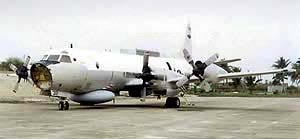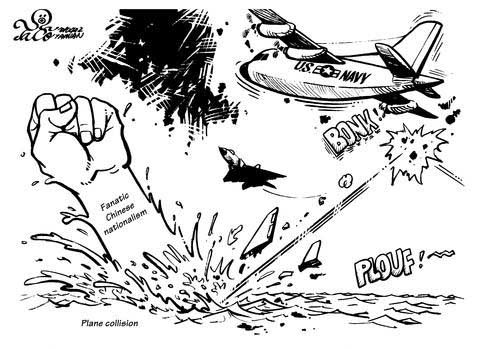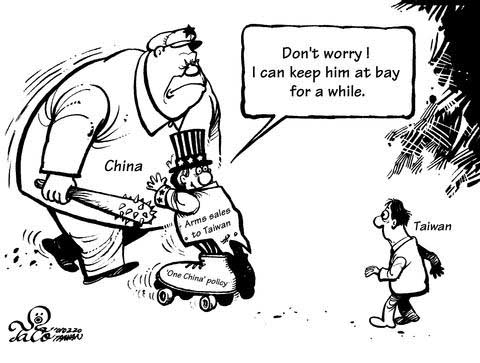 Taiwan
Communiqué No. 96, April 2001
Taiwan
Communiqué No. 96, April 2001 Taiwan
Communiqué No. 96, April 2001
Taiwan
Communiqué No. 96, April 2001
The collision between the American EP-3 Aries II surveillance aircraft and a Chinese F-8 fighter jet some 65 nautical miles off the coast of Hainan and its aftermath are serving as a wake-up call to the United States and Western Europe. The incident is highlighting the increasingly aggressive stance China has been taking vis-à-vis its neighbors and towards the US role in the region.
The Bush administration tried to defuse the matter, and focused on getting the 21-man and three women crew back to the United States. The Chinese authorities, however, played it up, and tried to wring as many concessions as possible out of the United States -- in particular a formal apology and "full responsibility" — before returning the crew.
At the time of this writing the crew had not been released yet, making a full assessment of the cause of the accident impossible. But from all information available through the news media it appeared that the Chinese jet had flown far too close, right under the slow surveillance propeller aircraft. According to a report in the New York Times ("US aides say Chinese pilot reveled in risk", 6 April 2001) the Chinese pilot had in recent months flown so recklessly close to American surveillance aircraft that he was clearly recognizable on photographs. On one photograph he was even seen holding a paper with his e-mail address written on it.
As the respected US commentator Jim Hoagland wrote: "…the probability that an American spy plane deliberately rammed a Chinese jet fighter over the South China Sea on Sunday runs as close to a perfect zero as mathematics allows. Imagine a fully loaded moving van trying to ram a Harley-Davidson motorcycle on an open plain and you get the picture" ("Chinese Succession Plays Key Role in Spy Plane Drama", International Herald Tribune, 7 April 2001).

The plane collision is the first major foreign policy test of the newly established Bush administration. By all accounts, the new foreign policy team handled the situation well, trying to defuse the issue by expressing "regret" at the loss of the Chinese fighter and its pilot, but at the same time not falling into the "apology" trap. Any concession in that direction would have prompted the Chinese to up the ante and demand further concessions from the US.
The Chinese attempt to shift blame to the United States is intended to divert attention from the fact that China itself has significantly increased military tension in the area. It has positioned some 300 missiles on the coast opposite Taiwan, growing at a rate of 50 per year. It has purchased Russian Sukhoi-27 and _30 fighter aircraft and Sovremenny destroyers with the specific intent to threaten and bully a peaceful and democratic neighbor, Taiwan.
It is preventing a free and democratic nation, Taiwan, from being accepted as a full and equal member of the international community, and is threatening it with attack and invasion if it would declare independence.
The American surveillance flights are thus an essential element in preserving peace and stability in East Asia. It is only careful and prudent to keep a close watch on Chinese growing military power. In fact, according to press reports in Taiwan, the EP-3 surveillance flight was monitoring Chinese maneuvers with its newly-purchased Sovremenny destroyers.
During the past couple of months — even before the collision of the Chinese fighter aircraft with the US surveillance plane -- there has been an increasingly hot debate about the upcoming US decision to sell advanced weaponry to Taiwan. The decision is part of the annual cycle mandated by the 1979 Taiwan Relations Act.
The matter received increasing attention because it would be the first by the new Bush Administration. Mr. Bush and his team had indicated they would be much more firm and forthright than the wishy-washy Clinton Administration. The Chinese thus attempted to pull all strings to try to prevent the sale, in particular of four Aegis destroyers, which would enable Taiwan to set up a potent defense system, in particular against the some 300 missiles set up by China along its coastline opposite Taiwan.
While the 1 April 2001 aircraft accident formally has no bearing on the sale of defensive weapons to Taiwan, it is indeed illustrative of Taiwan's need for those weapons. If China already shows such aggressive and recalcitrant behavior vis-à-vis the United States, what treatment can a small and relatively much weaker nation of Taiwan expect?
The accident thus strengthens the case for full support of Taiwan, not only by strengthening the democratic island's capability to defend itself, but also by enhancing its acceptance as a full and equal member of the international community, and by moving towards normalizing diplomatic relations with the island. Leaving a solution to "talks between the two sides" is naïve and incompatible with internationally-accepted principles of democracy and self-determination.
In the following article we first present the case for the sale of the Aegis, and then give a reprint of an article by Mr. Li Thian-hok, titled "It's time to choose fight or flight." At the time of this writing, no decision on the Aegis sale had been made yet.

The proposed sale of four Arleigh Burke class destroyers equipped with the Aegis radar system, at a cost of some US$ 1.2 billion each, is a major decision for both the United States and Taiwan. It is part of the present package of military sales to be approved by President Bush. The package does include a broad array of weapon systems, which have been discussed for a number of years, including PAC-3 anti-missile batteries, the P-3 Orion anti-submarine aircraft, diesel submarines, Kidd-class destroyers, and the HARM anti-radiation missile.
The latter systems are important to beef up Taiwan's defenses: the PAC-3 to help defend the population centers and strategic locations against incoming missiles; the P-3 Orion and the diesel submarines against the more that 60 Chinese submarines, including four Kilo-class purchased from Russia.
However, the most important is the sale of the four Arleigh Burke class destroyers equipped with Aegis. It has become symbolic for the long-term US commitment to the defense of Taiwan, because the powerful Aegis radar that can track hundreds of targets and defend against aircraft, submarines, surface ships and cruise missiles, and with planned upgrades will be able to stop ballistic missiles as well.
The sale of Aegis destroyers was also considered last year by the Clinton administration, but postponed for a year, because Mr. Clinton didn't want to increased tension with China in his last year in office.
China has objected strenuously against the sale because it would pull the rug from under the Chinese strategy to try to subdue Taiwan with a mixture of oral threats, and intimidation with the some 300 missiles deployed along the coast opposite Taiwan and the threat of a blockade of Taiwan's ports with its submarines.
On the US side, objections to the sale fall into two groups: 1) those who argue that the sale would "increase tension" with China, and 2) those who argue that Taiwan's navy does not have adequate manpower to deal with such a complex warship, and that would be better served by a less complicated system.
The first objection totally disregards the fact that it is China that is increasing tension with its threats and intimidation against Taiwan. Tension could be reduced easily if China would dismantle the some 300 missiles, decommission its submarines, and accept Taiwan as a friendly neighbor instead of perpetuating the 50-years old Civil War.
The second objection can be dealt with over time: it takes some 7 to 8 years for the ships to be built. In the meantime, the US could provide Taiwan with an extensive training program, and could provide the island with a less-complicated system, such as the Kidd-class destroyer, so the men and women of Taiwan's navy will have adequate preparation for their future tasks.
The arguments in favor of the sale of the four Arleigh Burke-class destroyers equipped with Aegis can be summarized as follows:
1. It is a much-needed defense system against China's increasing military threats against Taiwan, and in particular the some 300 missiles deployed along the Chinese coast opposite Taiwan.
2. It has become symbolic for the US resolve to help defend Taiwan. Further postponement will only be a signal to China that its bullying is having an effect and can deter the United States from taking this important step.
3. It lays the foundation for a long-term overall defense system under the Theatre Missile Defense Structure (TMD), which would help defend Japan, Korea and Taiwan. The Aegis is an essential building block for this system.
4. Taiwan and its newly-elected DPP government could certainly use a well-deserved practical and moral boost in the continuing struggle to safeguard freedom and democracy, and protect the island from Chinese invasion.
5. A final reason in favor of the arms sales is the fact that China recently announced its largest increase in military spending in 12 years, a rise of US$17 billion, or 17.7 percent. The Chinese made no secret of the fact that "Taiwan" was one of the most important reasons for the increase.
By Li Thian-hok. Mr. Li is a prominent member of the Taiwanese-American community who lives in Pennsylvania.

Visiting New York on 20 March 2001, Chinese Vice Premier and the gray eminence of China's foreign policy establishment Qian Qichen declared that Sino-U.S. relations would suffer a very serious setback if the U.S. were to sell the Aegis destroyers to Taiwan. "The essence of the issue would change from a peaceful approach to reunification to a military approach," Qian said. Asked if that meant immediate, preemptive attack on Taiwan, he said: "It all depends on the circumstances." While Qian refrained from raising the arms sales issue with President Bush in the Oval Office on 22 March 2001, he again invoked the specter of a great flame of war at a Washington luncheon the next day.
So what are these Aegis destroyers which alarm Beijing so much? Taiwan is seeking to purchase four Arleigh Burke class destroyers equipped with the Aegis battle management system at about $1 billion each this year. The Aegis' long range radar would give Taiwan early warning for optimal deployments of its forces. The destroyers are equipped with missiles, guns and torpedoes. Its radar system can track and defend against over 100 targets simultaneously. The ship's state-of-the-art command and control capabilities would give Taiwan's military the much needed ability to coordinate the operation of all its forces. If combined with newer submarines and anti-sub aircraft, the Aegis destroyers could help deter a blitzkrieg by air and sea or a naval blockade by China.
China has been aggressively acquiring advanced destroyers, warplanes, submarines and other weaponry from Russia and Europe. It has targeted over 300 missiles on Taiwan. The number of missiles deployed is expected to increase to 1,000 by 2005. While the purchase of four Aegis destroyers by Taiwan will complicate China's plan for a quick military conquest of Taiwan before the U.S. can react, these ships by themselves are not likely to be a decisive factor in a conflict, given China's overwhelming advantage in the size of its forces, and the modernization of the People's Liberation Army (PLA). So why is Beijing so adamant in opposing the sale of the Aegis destroyers?
The Aegis destroyers will take 7 to 8 years to build and deploy. The Aegis could become the platform for a highly effective anti-missile defense system when transferred to Taiwan late in the decade. Such a system will not only undermine China's missile threat but also result in close military cooperation between the U.S. and Taiwan, which China fears may turn into a de novo defense alliance.
China is also drawing a red line on the Aegis sale to test the resolve of the Bush administration early. Because of the 36-day stalemate in the Florida election, the administration is behind schedule in assembling its foreign policy staff at State, the Pentagon and the White House. The administration hasn't had adequate time to develop its own policy on China, Taiwan and arms sales to Taiwan. Beijing may calculate this is a good time to try its intimidation tactic, which has worked so well during the Clinton years, on the new Bush team.
On the U.S. side, there are those who feel that avoiding a rift in relations with Beijing should be our priority, arguing that no amount of arms will preserve Taiwan's security in any event. We should not sell the Aegis ships to Taiwan, some even assert, lest these advanced weapons fall into PLA hands should Taiwan elect to capitulate.
On the other hand, there are persuasive reasons for authorizing the Aegis sale. Under the Taiwan Relations Act, which was affirmed by President Bush, the U.S. is obligated to sell Taiwan sufficient defense articles and services for its defense needs. The decisions on such arms sales are to be made without prior consultation with China and based solely on consideration of the military balance between Taiwan and China. There is strong support in Congress for the Aegis sale, including Senators Jesse Helms and Trent Lott. Over 70 U.S. lawmakers have signed letters to President Bush, urging full consideration to sell Taiwan the Aegis destroyers. The U.S. navy and defense contractors are lobbying for the Aegis sales.
Inside the beltway, a number of compromise solutions have been proposed. While the details differ, the key elements are, first a deferral of the sale decision for another year, contingent on certain Chinese behavior, including freezing or reduction of the number of missiles deployed against Taiwan, and resumption of dialog with Taiwan without the precondition that Taipei forfeit its sovereignty first.
Second, the construction of the ships is to commence right away so they can be delivered in a timely manner if the sale is approved. Otherwise, the ships can be sold to other countries or retained for the U.S. navy. Actually, Beijing has already rejected the contingent conditions so there are no valid reasons for delaying the building of the ships. Avoidance of Beijing's anger is not a proper reason for delaying a decision. However, giving the Bush administration time to develop a shared world strategic view and a set of strategic goals in East Asia before it acts on the Aegis sale would be a sensible ground for delay. Taiwan's navy could also use the time to train qualified sailors in sufficient number, in anticipation of the acquisition of the Aegis' platforms. The Kidd destroyers could serve as stepping stones in this process.
Taiwan's more immediate needs include the PAC-3 anti-missile batteries, the P-3 anti-sub aircraft, diesel submarines, and the HARM anti-radiation missiles. Beyond the weaponry, Taiwan urgently needs assistance from the U.S. military in defense planning and training. The Chen government needs to convey to the Bush administration its determination to defend Taiwan's democracy, both in words and deeds.
Actions which need to be taken include an increase in Taiwan's defense budget, hardening of hangars and warehouses to protect aircraft, ammunition and other military assets, conducting more frequent joint-force exercises, building shelters to minimize casualties in case of conflict, implementing passive and civil defense, and above all, prepare the Taiwanese people psychologically for the looming military conflict.
Escalating concessions to China has not changed Beijing's bellicose stance and the PLA continues to build up its capability to quickly overwhelm Taiwan. Under these circumstances, strengthening national defense should be Taiwan's urgent priority. Failure to do so will tempt China to attack.
A great majority of the 23 million Taiwanese people prefer the status quo. The people should be made aware that preservation of the status quo requires courage, sacrifice and high resolve to defend the homeland against Chinese aggression. By constantly threatening Taiwan and actively preparing for war, China has abrogated the basic premise of the three joint communiqués that no coercion will be used to settle Taiwan's future status. For Taiwan as well as the U.S., now is the time to choose between "fight or flee." The Aegis decision is the litmus test. Will Washington make the right decision in time?
This article was first published in the Taipei Times on 3 April 2001. Reprinted with permission.
Back to: Table of Contents
Copyright © 2001 Taiwan Communiqué